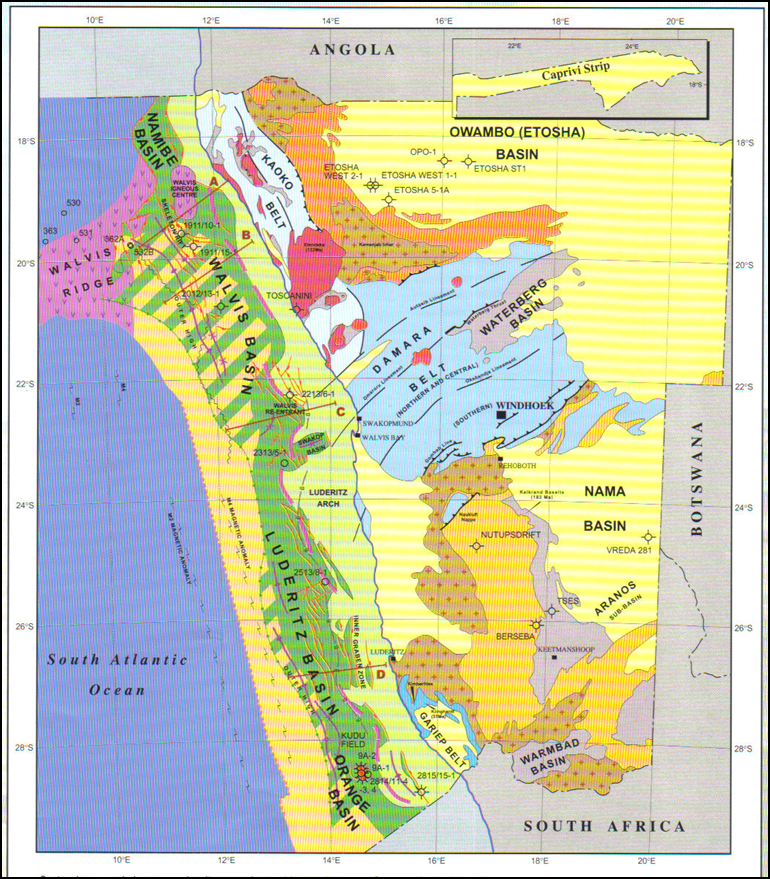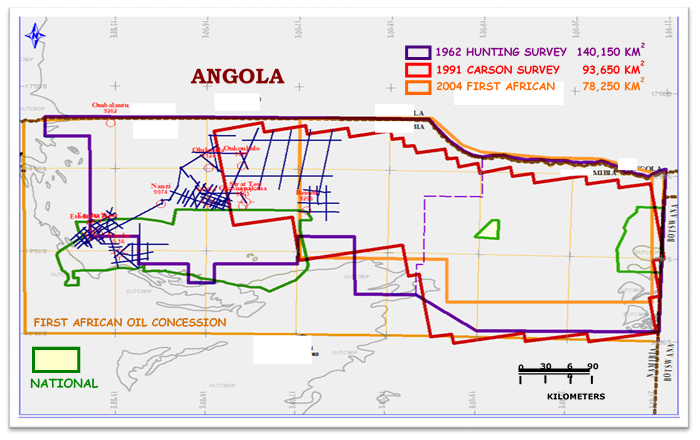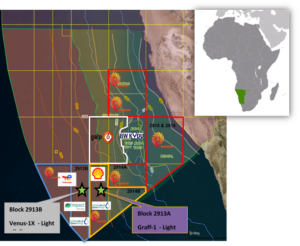History
section-1774ec5
History
history on Namibian onshore & offshore exploration activities

Namibia has four (4) offshore and three (3) sedimentary basins which have undergone exploration activities over the years (Figure 1). The offshore sedimentary basins includes; the Orange Basin, the Lüderitz Basin, the Walvis Bain and the Namibe Basin. The offshore basins cover an area of about 825, 418 km² with a water depth ranging from 0-4,000m extending from the South African maritime border in the south to the Angolan maritime border to the north. Namibia’s onshore basins covers approximately 60% of the country’s vast where the exploration interest are the two Neoproterozoic/Early Cambrian Basins, the Owambo-Etosha Basin to the northern part and the Nama Basin in the south of the country. These two basins cover over 470,000 km² flanked by early Cambrian pan-African orogenic belts.

Several Operators have been exploring Central and South Onshore Namibia since the late 1920's. The first Operator in the Nama Basin was South West Africa Petroleum Corporation which drilled well Berseba-1 in 1928 (1,009m). After a long period of no activities, in 1963, Artnell Exploration Company drilled well Vreda-1 (1,840 m). Five years late (1968) De Beers and Shell/BP held a concession in the southern Nama Basin. De Beers carried out 360-line km of 2D seismic (3 lines) in the Berseba and Tses area and well Tses-1 was drilled up to 2225 m. During the mid-1980s, over 36 shallow boreholes were drilled in the Aranos area investigating coal deposits. In 1992 NAMCOR commissioned a detailed aeromagnetic survey of 27,000-line km in the northern part of Nama Basin and drilled wells ND-1 and ND-2. In 2003, INA was awarded a Reconnaissance License and carried out the acquisition of Airborne Gravity and Magnetic data in 2005 and further went on to acquire 500 line-km (5 lines) of 2D seismic survey between 2007-2009.
Equally, in 1959, Texas Eastern (Etosha Petroleum Company) (Pty) Ltd purchased the first exploration rights to the Owambo Basin and in 1962 acquired approximately 140,150 km² of aeromagnetic and gravity data over the Basin (Figure 2). The company went on to drill the Stratigraphic test well (Strat-Test-1) in 1964. Between 1965 - 1970, an intensive reconnaissance exploration program comprising geological, 2D seismic (2,010 line-km acquired), and geochemical surveys (19,220 km² acquired) and drilling of three (3) wells i.e., Etosha West 1-1, Etosha West 2-1 and Etosha 5-1A were undertaken. To assess the presence of an oil source rock, 15 cutting samples were collected from the wells.
From 1983 – 1989, there was no onshore exploration activity and activities only resumed from 1990-1991 with the acquisition of 800 line-km of 2D seismic survey by Overseas Petroleum and Investment Corporation (OPIC) Namibia and 93, 650 km² of aeromagnetic and gravity data. Equally, in 1993 OXY conducted a soil gas survey of 203 sites. Similarly, from 1994 – 2002 there were no onshore exploration activities and activities only resumed in 2004 with the acquisition of 78,250 km² of aeromagnetic and gravity data by First African Oil.
To date, onshore exploration in the Owambo-Etosha Basin has advanced with the acquisition of aeromagnetic and gravity survey by Preview Energy (5,925 km in 2012), Hydrocarb Energy (13,468 km of in 2013) and ACREP (24, 850 km in 2015) and 120 km 2D survey carried out by CGG in 2017. In 2021-2022, Reconnaissance Africa drilled three stratigraphic wells; Mbambi (ST 6-1), Kawe (ST 6-2), and Makandina P33, and acquired over 700 line-km of 2D seismic data in the Okavango Basin.
 The 1st Phase or First Licensing round opened in 1969 with 8 blocks being awarded, the 2nd licensing round opened in 1972 with 9 blocks being awarded. The Kudu Gas discovery (Kudu 9A-1) was drilled during this time by Chevron, Regent and SOEKOR in the Orange Basin. With the UN sanctions from later 1970’s no further exploration for hydrocarbons was done by international operators. During that time, all drilling rights were then transferred to SWAKOR (nascent national oil company). However, 1987-1988 the 2nd Phase of exploration began with SWAKOR, the predecessor company of the present National Oil Company, NAMCOR, in collaboration with Halliburton. They acquired 10,600km 2D seismic offshore Namibia and a further 3,770 km over Kudu and drilled Kudu 9A-2 and Kudu 9A-3. The Kudu 2 well was not tested but Kudu 9A-3 proved a dry gas discovery in Lower Cretaceous sands.
The 1st Phase or First Licensing round opened in 1969 with 8 blocks being awarded, the 2nd licensing round opened in 1972 with 9 blocks being awarded. The Kudu Gas discovery (Kudu 9A-1) was drilled during this time by Chevron, Regent and SOEKOR in the Orange Basin. With the UN sanctions from later 1970’s no further exploration for hydrocarbons was done by international operators. During that time, all drilling rights were then transferred to SWAKOR (nascent national oil company). However, 1987-1988 the 2nd Phase of exploration began with SWAKOR, the predecessor company of the present National Oil Company, NAMCOR, in collaboration with Halliburton. They acquired 10,600km 2D seismic offshore Namibia and a further 3,770 km over Kudu and drilled Kudu 9A-2 and Kudu 9A-3. The Kudu 2 well was not tested but Kudu 9A-3 proved a dry gas discovery in Lower Cretaceous sands.
Post 1990 the First (1st) Licensing round was held with Five (5) licenses being awarded (Norsk Hydro, Ranger, Sasol, Chevron and Shell). Subsequently, in 1995 the Second Licensing round was held and resulted in two new licenses being awarded to Shell with an extension to the existing license that Shell had over the Kudu Field. During this period, over 28,000km of 2D seismic was acquired in the respective licenses, as well as 60,000km of multi-client data.
The Third (3rd) Licensing Round in 1998-1999 resulted in no applications being received, due to low oil prices and the numerous international company mergers that were ongoing. The exploration period between 1991 and 1998 saw nine exploratory wells drilled and located mostly on the shelf. Although unsuccessful, these wells proved both clastic and carbonate potential reservoirs of mostly Cretaceous age and at least two rich oil-prone rocks within the Aptian and Cenomanian/Turonian interval. The mini-4th Licensing Round in 2004 eventually resulted in the award of two blocks to BHP-Billiton to the west and south of the Kudu Gas Field.
With an open licensing system adopted in 1999, Namibia experienced an influx in exploration activities from 2008 to date, especially the acquisition of 2D and 3D seismic surveys (create a link to the 2D and 3D maps)as more companies showed interest in the hydrocarbon potential of the West African margin. Within this period six (6) exploratory wells were drilled by various operators: Sintezneftegaz drilled Kunene-1 Well in 2008, Chariot Oil & Gas drilled Tapir South-1 and Kabeljou-1 Wells in 2012, HRT drilled Wingat-1, Murombe-1 and Moosehead-1 Wells in 2013 and Repsol drilled Welwitschia-1 Well in 2014. Some of these well results confirmed the presence of Lower Cretaceous clastic and carbonate reservoirs and also proved an oil-based working petroleum system with two thick, rich mature source rocks within the Aptian interval. In 2018, two (2) wells were drilled in the Walvis Basin by Tullow Namibia (Cormorant-1) and Chariot Oil & Gas (Prospect S) respectively. However, the targeted Albian Fan sandstones were found to be water-bearing with wet gas signatures. These Albian fan sandstones were encountered in the overlying shale section. The latter, Chariot Oil and Gas (Prospect S) penetrated the targeted turbidite reservoir sands, however the reservoirs were found to be water-bearing. The recent drilling campaigns in 2021/2022 by Shell Namibia (Graff-1) and TotalEnergies (Venus-1X.T1) made significant light oil discoveries with associated gas within the Orange Basin.
To date, a total of 27 wells (Exploration and Appraisal) were drilled offshore Namibia Wells base map with over 30 currently active Petroleum Exploration Licenses Hydrocarbon license map having been awarded by the Ministry of Mines and Energy.
